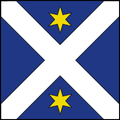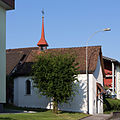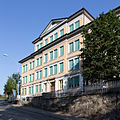Malters
| Malters | |
|---|---|
| State : |
|
| Canton : |
|
| Constituency : | Lucerne Country |
| BFS no. : | 1062 |
| Postal code : | 6102 |
| Coordinates : | 656 594 / 209725 |
| Height : | 512 m above sea level M. |
| Height range : | 456–919 m above sea level M. |
| Area : | 28.57 km² |
| Residents: | 7318 (December 31, 2018) |
| Population density : | 256 inhabitants per km² |
|
Proportion of foreigners : (residents without citizenship ) |
11.5% (December 31, 2,015) |
| Website: | www.malters.ch |
|
Malters |
|
| Location of the municipality | |
Malters is a municipality in the Lucerne-Land constituency in the canton of Lucerne in Switzerland .
geography
Malters is located 10 km west of the city of Lucerne . From the Kleine Emme the municipal boundary leads along the Ränggbach to Renggloch . There it swings to the west - along the heavily wooded northern slope of the Blattenberg . The largest forest areas on this northern slope are the Blattenwald , Sitenwald , Gspanwald and further west the Vogelwald . As far as the Rümlig , the municipal boundary then runs in a south-westerly direction. It then follows northwards to the confluence of the Rümlig in the Kleine Emme its stream. In the Kleine Emme it goes westwards for a short time before it leaves the river at Muffenhus and after a short north twist turns east along the Hinteren Emmenberg . At the Holzhubelhöhe ( 763 m above sea level ) it turns to the Hellbühler Rotbach in a northerly direction. After a short border line along this body of water, it goes southeast to the Thorenberg Canal west of the Thorenberg power station . Then to the Kleine Emme in the southwest and in this westwards back to the confluence of the Renggbach in the Kleine Emme.
The village of Malters is located south of the Kleine Emme on the Lucerne-Wolhusen road and has merged with the former hamlets of Feld and Schachen . The district of Blatten ( 479 m above sea level ) is 3 km east of the village. The hamlet of Rengg (4.2 km; 539 m above sea level ) is located even further to the east .
In the west of the village, on the road to Wolhusen , there are the hamlets Ettisbühl (1.5 km; 507 m above sea level ; flowed through by the Kesselbach ), Ennigen (2.3 km; 513 m above sea level ) and directly east of the Rümligbach Zil (3 km from the village; 520 m above sea level ).
A not insignificant part of the municipality is located north of the Kleine Emme. For a short time (1798–1803) this formed the independent municipality of Brunau . It consists of dozens of hamlets, groups of houses and individual farms. Except for the large Buggenringerwald and the smaller forest areas Gischwald and Brüschwald , the area has been cleared. The three largest settlements are Zinggen (2.7 km north-north-east of the village; 654 m above sea level ), Buggenringen (3.7 km north-east; 562 m above sea level ) and Brunauerhof (2.3 km north-east; 478 m above sea level) . M. ).
64.7% of the community area is used for agriculture. Around a quarter (24.7%) is covered by forest and almost a tenth (9.5%) is settlement area.
Malters borders on Entlebuch , Kriens , Lucerne , Neuenkirch , Ruswil , Schwarzenberg and Werthenstein .
population
Between 1798 and 1850 the population increased very sharply (1798–1850: +72.5%). In 1850, Malters was the third largest municipality in the canton of Lucerne after the city of Lucerne and Ruswil. In the wake of the general rural exodus due to industrialization in the second half of the 19th century, Malters lost a significant part of its population by 1888 (1850–1888: −16.6%). By 1970, there was an increase in the number of inhabitants with several strong growth phases between 1888 and 1910, the 1920s and 1950 to 1970 (1888–1970: +73.5%). The population decreased in the 1970s. The number of residents has been growing steadily since 1980 (1980–2016: + 45.1%). This growth is based on the affiliation to the Lucerne region with its strong economic growth.

Sources: 1798–1837: Helvetic and cantonal censuses; Federal Office for statistics; 1850 to 2000 census results, 2010 ESPOP, since 2011 STATPOP
languages
The population uses a highly Alemannic dialect as their everyday language. In the last census in 2000, 93.16% said German, 2.79% Albanian and 0.82% Serbo-Croatian as their main language.
Religions - denominations
The entire population used to be members of the Roman Catholic Church. This has changed as a result of leaving the church and immigration from other regions in Switzerland and abroad. Today (as of 2000) the religious landscape looks like this. There are 75.91% Roman Catholic and 9.53% Evangelical Reformed Christians. In addition, there are 4.98% non-denominational, 3.84% Muslim and 1.01% members of other non-Christian denominations. Apart from a few Bosniaks, the Muslims are Albanians from Kosovo and Macedonia. The members of other non-Christian denominations are Hindus of Tamil origin.
Origin - nationality
At the end of 2016, 6244 of the 7,108 inhabitants were Swiss and 864 (= 12.16%) were foreigners. At the end of 2016, the ten most important migration groups came from Germany (228 people; 3.21%), Macedonia (97 people; 1.36%), Kosovo (93 people; 1.31%), Portugal (56 people; 0.79%) ), Italy (54 people; 0.76%), Eritrea (50 people; 0.70%), Serbia (32 people; 0.45%), Sri Lanka (31 people; 0.44%) and Austria (18 People; 0.25%). At the end of 2015, a total of 12.4% of immigrants were of non-European origin.
history

Malters is first mentioned historically around 840 in a document from the Benedictine monastery in the courtyard in Lucerne under the Latin name Maltrensi marcha (Mark Malters). In a document written in the second half of the 8th century, two nobles donated their goods in Malters to the Benedictine monastery in Lucerne. Later - before 1135 - it became the property of the Murbach Monastery in Alsace together with the Lucerne Monastery . In 1291 the Habsburgs acquired the community and assigned it to the Rothenburg office. After the Battle of Sempach , Habsburg lost control. The von Moos and later Mantzet families ruled the community. In 1477 the city of Lucerne acquired the place. Together with Littau, Malters was a bailiff from 1481 to 1798. It has belonged to the Lucerne Office since 1803 . The Lucerne government troops defeated the fleeing troops of the Freischaren on the night of March 30th to 31st, 1845 (see battle at Malters ). Since Malters, located in the valley floor, was conservative and the upper part of the village was liberal, the latter was made an independent municipality of Schwarzenberg by parliamentary resolution and separated from Malters. The Swiss family name Bucheli originally comes from Malters.
politics
Municipal council
The Malters municipal council consists of five members and is set up as follows:
- Sibylle Boos-Braun ( FDP ): Mayor
- Marcel Lotter ( CVP ): Mayor
- Christine Buob (CVP): Social Director
- Hans Wyss (independent)
- Dani Wyss (FDP)
Cantonal elections
In the 2019 Cantonal Council elections in the Canton of Lucerne, the share of the vote in Malters was (in brackets, change in percentage points since 2015): CVP 25.54% (-6.55), FDP 23.24% (-0.20), SVP 19.05 % (-5.51), SP 11.14% (+4.21), glp 8.85% (+4.90), GPS 6.05% (+0.89).
National Council elections
In the Swiss parliamentary elections in 2019, the share of the vote in Malters was (in brackets, change in percentage points since 2015): SVP 27.47% (-3.24), CVP 23.29% (-1.08), FDP 17.70% ( -0.28), SP 10.77% (+0.06), GPS 9.83% (+3.21), glp 9.07% (+3.42).
traffic
The community is on the Lucerne-Langnau i. E.-Bern and has its own train station. Malters train station is served every 20 minutes during rush hour and every half hour at off-peak times. The station consists of a double-track system with a central platform that can be reached through an underpass. A kiosk and a hairdresser are located in the station building. 1400 people get on and off at Malters every day. In 2005 the ticket counter was lifted and the station was automated. Since then, it has been remote-controlled from Lucerne. From autumn 2010 the station was renovated for 15 million francs. The inauguration took place on November 17, 2011, and since then the station has offered a handicapped accessible underpass to the newly created and partially covered central platform with waiting room.
The following trains stop at Malters station:
- RE Luzern - Wolhusen - Bern / Langenthal as S7
- S 6 Lucerne - Wolhusen - Langnau i. E. / Langenthal
- S 77 Lucerne - Willisau
These bus connections exist in Malters:
| line | route | Operated by |
|---|---|---|
| Line 211 | Malters-Schwarzenberg-Eigenhal | PostBus |
| Line 212 | Wolhusen Spital-Schachen-Malters | Rottal Auto AG |
| N5 night star | Lucerne-Malters-Wolhusen-Schüpfheim-Schangnau | PostBus / VBL |
Malters is located on the main road Lucerne - Wolhusen (- Bern) and has an entrance to the road between Littau and Werthenstein. The next motorway junction in Emmen on the A2 is 12 km away.
Personalities
Sons and daughters of the church
- Hugo Siegwart (born April 25, 1865 - † July 10, 1938 in Lucerne), sculptor and medalist
- Ignaz Burri (born September 12, 1872 - March 13, 1958 in Malters), politician
- Julius Voegtli (born March 29, 1879 - † November 21, 1944 in Biel / Bienne), painter
- Oskar Burri (born January 16, 1913; † April 23, 1985 in Zumikon), architect and interior designer
- Silvana Bucher (born February 3, 1984), cross-country skier, junior world champion
- Ramona Bachmann (born December 25, 1990), soccer player, Swiss national player
Other personalities in connection with Malters
- Ulrich Ochsenbein (born around November 11, 1811 in Schwarzenegg; † November 3, 1890 in Port), Swiss politician and general; Irregular leader in action at Malters
- Jakob Stämpfli (born February 23, 1820 in Janzenhaus near Wengi, † May 15, 1879 in Bern), lawyer, journalist, politician and Federal President; Irregulars in action at Malters
- Josef Leopold Brandstetter (born April 2, 1831 in Beromünster, † April 15, 1924 in Lucerne), doctor and scholar; ordained in Malters
- Armin Meili (born April 30, 1892 in Lucerne; † October 21, 1981 in Zurich), architect and politician; created the Daheim settlement in Malters
- Thomas Lötscher aka «Veri» (* 1960 in Entlebuch LU), cabaret artist; lives in Malters
- Miriam Wettstein (* in Basel), singer (mezzo-soprano); teaches solo singing at the Malters Music School
Attractions
The pilgrimage church of St. Jost is located in the Blatten district . From a chapel (1391), the present-day Rococo church emerged through various additions and extensions over the years .
photos
literature
- Adolf Reinle : St. Jost in Blatten. (Swiss Art Guide, Volume 521). Ed. Society for Swiss Art History GSK. Bern 1992, ISBN 3-85782-521-9 .
- Barbara Hennig, André Meyer: The Art Monuments of the Canton of Lucerne, Volume II: The Office of Lucerne. The rural communities. (Art Monuments of Switzerland, Volume 116). Edited by the Society for Swiss Art History GSK. Bern 2009, ISBN 978-3-906131-90-0 , pp. 301-348.
- History of Malters and Schwarzenbergh. Räber & Cie, Lucerne 1946.
Web links
- Official website of the municipality of Malters
- Community profile of the cantonal statistical office (PDF, 109 kB)
- Waltraud Hörsch: Malters. In: Historical Lexicon of Switzerland .
Individual evidence
- ↑ Permanent and non-permanent resident population by year, canton, district, municipality, population type and gender (permanent resident population). In: bfs. admin.ch . Federal Statistical Office (FSO), August 31, 2019, accessed on December 22, 2019 .
- ↑ Permanent resident population according to nationality category, gender and municipality ( memento of the original from January 1, 2015 in the Internet Archive ) Info: The archive link was inserted automatically and has not yet been checked. Please check the original and archive link according to the instructions and then remove this notice. (Permanent resident population)
- ^ Barbara Hennig, André Meyer: The art monuments of the canton of Lucerne, Volume II: The office of Lucerne. The rural communities. (Art Monuments of Switzerland, Volume 116). Society for Swiss Art History GSK. Bern 2009, ISBN 978-3-906131-90-0 , pp. 323–347.
- ↑ Source: Robert Gubler, Population Development and Economic Changes in the Canton of Lucerne, Conclusion Table 1
- ↑ Balance of the permanent resident population according to demographic components, institutional structure, nationality and gender (Federal Statistical Office, STAT-TAB)
- ^ LUSTAT: Community profile Malters
- ↑ The Art Monuments of the Canton of Lucerne, New Edition Volume II: The Office of Lucerne, the Rural Communities , page 301
- ^ Object - LUSTAT Statistics Lucerne. Retrieved June 16, 2020 .
- ↑ National Council elections (party votes and party strength). In: Results of the National Council elections 2019. Federal Statistical Office, 2019, accessed on June 16, 2020 .
- ↑ Andreas Töns: Bahnhof Malters: The credit is there despite criticism . In: "Neue Luzerner Zeitung" from March 22, 2010.
- ↑ SBB News: Malters: SBB inaugurates new central platform.
- ^ Adolf Reinle: St. Jost in Blatten. (Swiss Art Guide, No. 521). Ed. Society for Swiss Art History GSK. Bern 1992, ISBN 978-3-85782-521-7 .

















